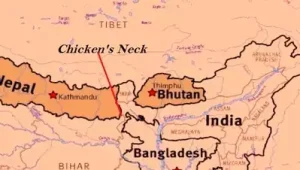Bangladesh’s Claim on Northeast India’s Connectivity
A recent statement by Muhammad Yunus, an advisor to Bangladesh’s interim government, has stirred controversy in India. Yunus claimed that India’s northeastern states are landlocked and heavily dependent on Bangladesh for maritime access. This assertion has fueled discussions about regional connectivity, national security, and India’s long-term infrastructure strategy.
The Northeast region, comprising eight states, is often perceived as geographically isolated due to its limited access to major ports and trade routes. While Bangladesh does offer logistical support for transport and trade, Indian leaders argue that the region is not entirely reliant on any external nation for connectivity.
Himanta Biswa Sarma’s Response and Strong Opposition
Assam Chief Minister Himanta Biswa Sarma firmly dismissed Yunus’s claims, asserting that such statements undermine India’s strategic efforts in the region. He labeled the remarks as misleading and emphasized that Northeast India is not landlocked in a way that makes it dependent on Bangladesh. Instead, India has been systematically strengthening its infrastructure to ensure seamless connectivity.
Sarma highlighted ongoing investments in highways, railway expansions, and inland waterways, which are designed to integrate the Northeast more effectively with the rest of India. These initiatives aim to boost economic growth, facilitate trade, and enhance national security.
He reaffirmed that the Northeast is a vital part of India’s economic and strategic framework, urging that it should not be perceived as reliant on any external entity for its development. The government’s focus, he noted, remains on self-reliance, improved logistics, and better integration of the region into the national economy.
The Strategic Importance of the Chicken’s Neck Corridor
The Chicken’s Neck corridor, also known as the Siliguri Corridor, is a strategically crucial yet vulnerable strip of land in northern West Bengal that serves as the only direct land link between the eight northeastern states and mainland India. This narrow, 22-kilometer-wide passage is surrounded by Nepal, Bhutan, Bangladesh, and China, making it a potential pressure point in times of geopolitical tensions or military conflicts. Any disruption—whether from border disputes, security threats, natural disasters, or infrastructure failures—could severely impact transportation, trade, and even national security.
Given these risks, security experts and policymakers have long advocated for alternative routes to ensure uninterrupted connectivity. The geographical challenges of the Northeast, with its mountainous terrain and limited transport networks, further emphasize the need for diversified access points. The Indian government has responded by initiating several large-scale infrastructure projects aimed at reducing reliance on the Chicken’s Neck.
One such initiative is the expansion of road and rail connectivity through Bhutan and Nepal, creating additional entry points into the Northeast. Several major highway projects, such as the East-West Corridor and Bharatmala Project, are being developed to improve direct road links. The Northeast Frontier Railway is also actively expanding rail networks, connecting key cities to mainland India.
In addition to land routes, India is strengthening its inland waterways to facilitate cargo movement via major rivers like the Brahmaputra and Barak. This will help reduce logistical dependence on traditional land routes while also promoting regional trade. The Kaladan Multi-Modal Transit Transport Project and the India-Myanmar-Thailand Trilateral Highway are also critical components of India’s strategy to establish alternative trade and transport corridors, allowing goods to bypass the Chicken’s Neck.
Moreover, India is enhancing air connectivity in the Northeast through the UDAN scheme, which aims to boost regional airport infrastructure. New air cargo hubs are being developed to improve trade and logistics, ensuring faster transportation of goods and services.
With growing geopolitical challenges, particularly in light of China’s increasing influence in the region, securing alternative connectivity routes has become an urgent priority. These measures will not only strengthen Northeast India’s integration with the rest of the country but also enhance economic development and national security in the long run.
India’s Plan for Alternative Infrastructure Development
In response to these concerns, the Indian government has been actively developing alternative routes to enhance Northeast India’s connectivity. Some of the key initiatives include:
1. Expanding Road and Rail Networks
– India is constructing new national highways and rail links to provide direct access to the Northeast without over-relying on the Chicken’s Neck.
– The Bharatmala and Sagarmala projects aim to enhance connectivity by integrating roads and inland waterways with the larger national transport grid.
– The Northeast Frontier Railway is expanding its network, connecting key cities in the region to major commercial hubs.
2. Enhancing Inland Waterways
– The government is investing in inland water transport systems to facilitate trade via rivers, reducing dependence on road and rail routes.
– The development of the Indo-Bangladesh Protocol Route has improved connectivity, but India is also strengthening its domestic waterways to ensure self-reliance.
– Plans to expand river-based cargo movement in the Brahmaputra and Barak rivers are underway.
3. Increasing Air Connectivity
– Several new regional airports are being developed under the UDAN scheme to enhance air connectivity between the Northeast and major Indian cities.
– Air cargo infrastructure is being strengthened to facilitate faster trade and transport of goods.
4. Developing Transnational Trade Corridors
– India is looking to strengthen trade ties with neighboring countries like Bhutan, Nepal, and Myanmar to reduce its dependency on any single route.
– The Kaladan Multi-Modal Transit Transport Project aims to connect India’s eastern seaboard with Myanmar, offering an alternative trade route.
– The India-Myanmar-Thailand Trilateral Highway is another ambitious project that will open up new trade corridors for the region.
Geopolitical and Economic Implications of the Connectivity Issue
While Bangladesh has historically facilitated transit for Northeast India, excessive reliance on a single country for trade and transport poses strategic vulnerabilities. Dependence on foreign infrastructure can lead to logistical challenges during political disputes, border tensions, or regulatory changes. Recognizing this, the Indian government is prioritizing self-reliance through large-scale infrastructure investments that align with its broader vision of national security and economic self-sufficiency.
Diversifying connectivity routes is crucial for unlocking the economic potential of the Northeast. Improved road, rail, and air connectivity will enable states like Assam, Arunachal Pradesh, and Meghalaya to emerge as major trade and tourism hubs. By enhancing accessibility, these states can attract foreign and domestic investment, foster industrial development, and create employment opportunities. Strengthening logistical networks will also allow businesses to expand operations, making the region a more attractive destination for manufacturing, agriculture, and service industries.
Additionally, boosting tourism in the Northeast requires world-class infrastructure. The region is home to unique cultural heritage, breathtaking landscapes, and diverse wildlife, all of which can contribute significantly to India’s tourism sector. Improved transport networks, better accommodation facilities, and seamless travel experiences will draw more visitors, generating revenue for local communities.
Sarma’s strong stance underscores the Indian government’s commitment to long-term infrastructure development. By reducing external dependencies, India can maintain greater control over its trade, security, and economic interests. Investments in multi-modal transport systems, such as highways, railway corridors, and waterways, will ensure uninterrupted connectivity while strengthening the region’s integration with the rest of the country.
The push for alternative routes also aligns with India’s Act East Policy, which aims to deepen economic and strategic ties with Southeast Asia. Projects like the India-Myanmar-Thailand Trilateral Highway will open up new trade opportunities, positioning the Northeast as a gateway to ASEAN markets. These initiatives will not only boost the region’s economy but also reinforce India’s geopolitical influence in the broader Indo-Pacific region.
Ultimately, reducing reliance on external transit routes ensures India’s long-term stability and growth. A well-connected Northeast will drive national development, improve security preparedness, and enhance India’s role in regional trade and diplomacy.


The recent controversy over Northeast India’s connectivity has brought to light the importance of long-term infrastructure planning. Assam CM Himanta Biswa Sarma’s response reflects India’s determination to secure and develop its northeastern frontiers while minimizing reliance on external routes.
Through strategic investments in roads, railways, waterways, and trade corridors, the region is set to become more integrated with the rest of the country. These efforts will not only strengthen national security but also unlock new economic opportunities for millions of people in the Northeast.
Read More: 10 Murals of Northeast India


